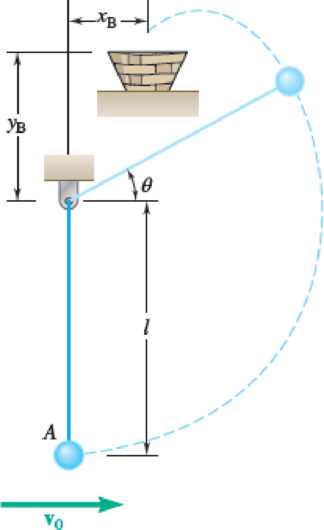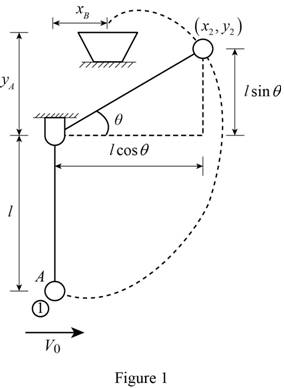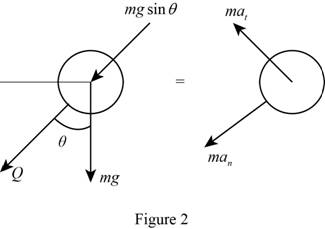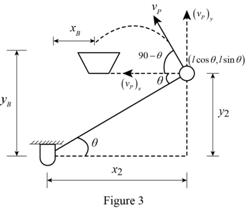
Concept explainers
The 2-lb ball at A is suspended by an inextensible cord and given an initial horizontal velocity of v0. If l = 2 ft, xB = 0.3 ft, and yB = 0.4 ft, determine the initial velocity v0 so that the ball will enter the basket. (Hint: Use a computer to solve the resulting set of equations.)
Fig. P13.201

Find the initial velocity
Answer to Problem 13.201RP
The initial velocity
Explanation of Solution
Given information:
The weight of the ball (m) is
The length of the cord (l) is
The horizontal distance between the basket and point of suspension of the ball
The vertical distance between basket and point of suspension of the ball
The acceleration due to gravity (g) is
Calculation:
Show the diagram of the suspended ball by an inextensible cord as in Figure (1).

Assume that position ‘1’ be at A and position ‘2’ be at the point described by the angle where the path of the ball changes from circular to parabolic.
The tension in the cord at position ‘2’, becomes slack
Refer Figure (1),
The expression for the x-coordinate of the ball at position ‘2’
The expression for the y-coordinate of the ball at position ‘2’
Show the free body diagram of the ball at position ‘2’ as in Figure (2).

The expression for the normal acceleration of the ball
Since, the cord becomes slack at position ‘2’, so the tension (Q) will be zero.
Calculate the velocity of the ball by applying Newton’s second law and resolve the forces acting on the ball at position ‘2’ using the relation:
Substitute
Substitute 0 for
The expression for the kinetic energy of the ball at position ‘1’
Calculate the potential energy of the ball at position ‘1’
Here, negative sign is used as the ball is located below the datum level and h is the vertical distance of the ball from the datum level.
Substitute
The expression for the kinetic energy of the ball at position ‘2’
The expression for the vertical distance of the ball by referring the Figure 1 as follows:
Calculate the potential energy of the ball at position ‘2’
Substitute
The expression for principle of conservation of energy at position ‘1’ and position ‘2’ for the ball, to calculate the angle swept by the ball
Substitute
Find the velocity at position 2:
Substitute
Show the parabolic motion of the ball after it reaches position ‘2’ as in Figure (3).

The expression for the velocity of the projectile ball after reaching the position ‘2’
Here,
The expression for the horizontal velocity component of the projectile ball along the negative X-axis as follows:
The expression for the horizontal distance between the basket and point of suspension of the ball
Here,
Substitute
Substitute
The expression for the vertical velocity component of the projectile ball along the negative X-axis as follows:
The expression for the vertical distance between the basket and point of suspension of the ball
Substitute
Substitute
Use trial and error method to calculate the value of
Case (1):
Try
Find the velocity at position 2:
Substitute
Find the time difference between basket and ball:
Substitute
Find the vertical distance between basket and ball:
Substitute
Case (2):
Try
Find the velocity at position 2:
Substitute
Find the time difference between basket and ball:
Substitute
Find the vertical distance between basket and ball:
Substitute
Case (3):
Try
Find the velocity at position 2:
Substitute
Find the time difference between basket and ball:
Substitute
Find the vertical distance between basket and ball:
Substitute
The expression for the data point as follows:
From above calculations, the following set of data points is obtained.
Calculate the general form of quadratic Equation.
Here, a, b, c are constants.
Substitute 0 for
Substitute
Substitute
Solve the equation (7) and equation (8).
Substitute
Substitute
Solve the above equation.
Calculate the angle
Substitute
Find the velocity at position 2:
Substitute
Find the initial velocity
Substitute
Therefore, the initial velocity
Want to see more full solutions like this?
Chapter 13 Solutions
Vector Mechanics for Engineers: Statics and Dynamics
- Required information An eccentric force P is applied as shown to a steel bar of 25 × 90-mm cross section. The strains at A and B have been measured and found to be εΑ = +490 μ εB=-70 μ Know that E = 200 GPa. 25 mm 30 mm 90 mm 45 mm B Determine the distance d. The distance dis 15 mm mm.arrow_forwardhandwritten-solutions, please!arrow_forwardhandwritten-solutions, please!arrow_forward
- ! Required information Assume that the couple shown acts in a vertical plane. Take M = 25 kip.in. r = 0.75 in. A B 4.8 in. M 1.2 in. [1.2 in. Determine the stress at point B. The stress at point B is ksi.arrow_forwardhandwritten-solutions, please!arrow_forwardhandwritten-solutions, please!arrow_forward
- No use chatgptarrow_forwardProblem 6 (Optional, extra 6 points) 150 mm 150 mm 120 mm 80 mm 60 mm PROBLEM 18.103 A 2.5 kg homogeneous disk of radius 80 mm rotates with an angular velocity ₁ with respect to arm ABC, which is welded to a shaft DCE rotating as shown at the constant rate w212 rad/s. Friction in the bearing at A causes ₁ to decrease at the rate of 15 rad/s². Determine the dynamic reactions at D and E at a time when ₁ has decreased to 50 rad/s. Answer: 5=-22.01 +26.8} N E=-21.2-5.20Ĵ Narrow_forwardProblem 1. Two uniform rods AB and CE, each of weight 3 lb and length 2 ft, are welded to each other at their midpoints. Knowing that this assembly has an angular velocity of constant magnitude c = 12 rad/s, determine: (1). the magnitude and direction of the angular momentum HD of the assembly about D. (2). the dynamic reactions (ignore mg) at the bearings at A and B. 9 in. 3 in. 03 9 in. 3 in. Answers: HD = 0.162 i +0.184 j slug-ft²/s HG = 2.21 k Ay =-1.1 lb; Az = 0; By = 1.1 lb; B₂ = 0.arrow_forward
- Problem 5 (Optional, extra 6 points) A 6-lb homogeneous disk of radius 3 in. spins as shown at the constant rate w₁ = 60 rad/s. The disk is supported by the fork-ended rod AB, which is welded to the vertical shaft CBD. The system is at rest when a couple Mo= (0.25ft-lb)j is applied to the shaft for 2 s and then removed. Determine the dynamic reactions at C and D before and after the couple has been removed at 2 s. 4 in. C B Mo 5 in 4 in. Note: 2 rotating around CD induced by Mo is NOT constant before Mo is removed. and ₂ (two unknowns) are related by the equation: ₂ =0+ w₂t 3 in. Partial Answer (after Mo has been removed): C-7.81+7.43k lb D -7.81 7.43 lbarrow_forwardProblem 4. A homogeneous disk with radius and mass m is mounted on an axle OG with length L and a negligible mass. The axle is pivoted at the fixed-point O, and the disk is constrained to roll on a horizontal surface. The disk rotates counterclockwise at the constant rate o₁ about the axle. (mg must be included into your calculation) (a). Calculate the linear velocity of G and indicate it on the figure. (b). Calculate ₂ (constant), which is the angular velocity of the axle OG around the vertical axis. (c). Calculate the linear acceleration ā of G and indicate it on the figure. (d). Determine the force (assumed vertical) exerted by the floor on the disk (e). Determine the reaction at the pivot O. 1 Answers: N = mg +mr(r/L)² @² |j mr w IIG C R L i+ 2L =arrow_forwardProblem 2. The homogeneous disk of weight W = 6 lb rotates at the constant rate co₁ = 16 rad/s with respect to arm ABC, which is welded to a shaft DCE rotating at the constant rate 2 = 8 rad/s. Assume the rod weight is negligible compared to the disk. Determine the dynamic reactions at D and E (ignore mg). Answers: D=-7.12ĵ+4.47k lb r-8 in. 9 in. B D E=-1.822+4.47 lb 9 in. E 12 in. 12 in. xarrow_forward
 Elements Of ElectromagneticsMechanical EngineeringISBN:9780190698614Author:Sadiku, Matthew N. O.Publisher:Oxford University Press
Elements Of ElectromagneticsMechanical EngineeringISBN:9780190698614Author:Sadiku, Matthew N. O.Publisher:Oxford University Press Mechanics of Materials (10th Edition)Mechanical EngineeringISBN:9780134319650Author:Russell C. HibbelerPublisher:PEARSON
Mechanics of Materials (10th Edition)Mechanical EngineeringISBN:9780134319650Author:Russell C. HibbelerPublisher:PEARSON Thermodynamics: An Engineering ApproachMechanical EngineeringISBN:9781259822674Author:Yunus A. Cengel Dr., Michael A. BolesPublisher:McGraw-Hill Education
Thermodynamics: An Engineering ApproachMechanical EngineeringISBN:9781259822674Author:Yunus A. Cengel Dr., Michael A. BolesPublisher:McGraw-Hill Education Control Systems EngineeringMechanical EngineeringISBN:9781118170519Author:Norman S. NisePublisher:WILEY
Control Systems EngineeringMechanical EngineeringISBN:9781118170519Author:Norman S. NisePublisher:WILEY Mechanics of Materials (MindTap Course List)Mechanical EngineeringISBN:9781337093347Author:Barry J. Goodno, James M. GerePublisher:Cengage Learning
Mechanics of Materials (MindTap Course List)Mechanical EngineeringISBN:9781337093347Author:Barry J. Goodno, James M. GerePublisher:Cengage Learning Engineering Mechanics: StaticsMechanical EngineeringISBN:9781118807330Author:James L. Meriam, L. G. Kraige, J. N. BoltonPublisher:WILEY
Engineering Mechanics: StaticsMechanical EngineeringISBN:9781118807330Author:James L. Meriam, L. G. Kraige, J. N. BoltonPublisher:WILEY





